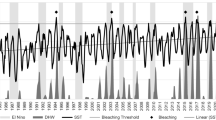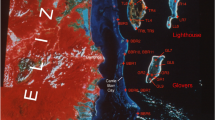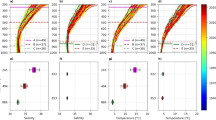These installations are home to thriving colonies of an endangered cold-water coral.
Abstract
This summer the coral Lophelia pertusa was found growing on oil platforms in the North Sea and on the Brent Spar oil-storage buoy during its decommissioning. The findings indicate that Lophelia has a wider distribution and a more rapid rate of growth than previously believed. The discovery also has implications for the debate over oil exploration in the Atlantic Ocean and the perceived benefits of onshore dismantling of deep-water platforms.
Similar content being viewed by others
Main
When Brent Spar was raised out of the sea in stages for dismantling (Fig. 1), colonies of Lophelia of up to 20 cm linear growth were found on the sides and bottom, which had been at depths of 60–109 m. Lophelia has recently been filmed at depths of 100–129 m on two platforms in the North Sea about 140 km east of the Shetland Islands. These domed colonies were up to 54 cm long, and were found on installations that have been producing oil since the late 1970s. Annual average linear growth rates of 25 mm have previously been suggested for this coral1, but more recent estimates of 5.5–6.0 mm have been proposed2. The size of the colonies on these 20-year-old platforms means that the average growth rate must have been at least 26 mm per year. If the colonies found on Brent Spar had grown at a similar rate, then Lophelia must have settled on the structure when it was in the Brent Field in the North Sea.
Lophelia is widespread in the Atlantic at depths of 150–1,500 m, but is particularly common on the upper continental slope at 200–600 m (refs 3,4). It has also been found at a depth of 50 m in Scandanavian fjords5, off the coast of Norway6, and on the Beryl platform7. Its occurrence on oil installations is the first recorded instance of live colonies of this species in the North Sea. It has been shown2 that Lophelia occurs at temperatures of 4–8 °C. At the original Brent Spar site (61° 03′ N, 01° 40′ E), the water temperature at the depth where the shallowest Lophelia were found can exceed 10 °C (ref. 8); in the area of the two production platforms, the maximum water temperature at depths of 100–129 m varies between 7.6 and 9.7 °C.
The presence of Lophelia on oil-producing platforms has implications for the licensing of oil exploration. Greenpeace contends that the British Department of Trade and Industry failed to consider whether licensed oil-producing areas that may contain Lophelia should be designated as potential special areas of conservation and, as such, is in contravention of the European Commission's Species Habitat Directive (92/43/EEC).
It has been suggested that Lophelia is susceptible to disturbance from increased sedimentation and from the toxicological effects of drilling discharges9,10. However, the apparently healthy colonies of Lophelia on platforms in the North Sea have been exposed to agreed quality standards of operational discharges, such as oily water, drilling muds and chemicals, and contaminants that may leak from the cuttings piles (E. Breuer, personal communication) that lie 10–15 m below some of the colonies. This indicates that it is not obviously affected by discharges from oil platforms.
The occurrence of the coral raises questions about how to deal with this species, which is listed under the Convention on International Trade in Endangered Species (CITES), when platforms are decommissioned. At a meeting in Sintra in 1998 of countries belonging to the Oslo–Paris (Ospar) convention on protecting the marine environment, Ospar decision 98/3 indicated that the ‘footings’ of large platforms (jacket weight of more than 10,000 tonnes) might be left in place. Such an option would preserve existing colonies and might allow Lophelia to spread in the North Sea.
References
Mikkelsen, N., Erlenkauser, H., Killingley, J. S. & Berger, W. H. Boreas 5, 163–171 (1982).
Mortensen, P. B. & Rapp, H. T. Sarsia 83, 433–446 (1998).
Wilson, J. B. J. Mar. Biol. Assoc. UK 59, 149–164 (1979).
Zibrowius, H. Mem. Inst. Oceanogr. Monaco 11, 126–130 (1980).
Strømgren, T. Det Kon. Nor. Vid. Sel. Skr. 6, 1–9 (1971).
Hovland, M., Mortensen, P. B., Brattegard, T., Strass, P. & Rokoengen, K. Palaios 13, 189–200 (1998).
Pearce, F. New Sci. 164(2211), 16 (1999).
Turrell, W. R. & Slesser, G. Marine Laboratory Aberdeen Report No. 1/99 (1999)
Rogers, A. New Sci. 154(2087), 53 (1997).
Edwards, R. New Sci. 154 (2085), 10 (1997).
Author information
Authors and Affiliations
Rights and permissions
About this article
Cite this article
Bell, N., Smith, J. Coral growing on North Sea oil rigs. Nature 402, 601 (1999). https://doi.org/10.1038/45127
Issue Date:
DOI: https://doi.org/10.1038/45127
This article is cited by
-
Fish associations with shallow water subsea pipelines compared to surrounding reef and soft sediment habitats
Scientific Reports (2021)
-
Localised anthropogenic wake generates a predictable foraging hotspot for top predators
Communications Biology (2019)
-
Ocean sprawl facilitates dispersal and connectivity of protected species
Scientific Reports (2018)
-
The effect of local hydrodynamics on the spatial extent and morphology of cold-water coral habitats at Tisler Reef, Norway
Coral Reefs (2018)
-
Morphology and sedimentology of (clustered) cold-water coral mounds at the south Rockall Trough margins, NE Atlantic Ocean
Facies (2009)
Comments
By submitting a comment you agree to abide by our Terms and Community Guidelines. If you find something abusive or that does not comply with our terms or guidelines please flag it as inappropriate.




